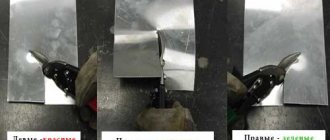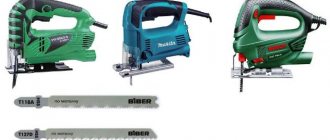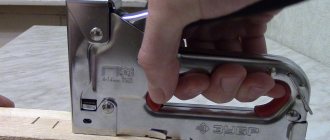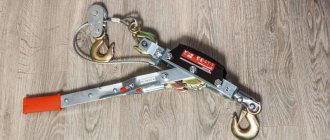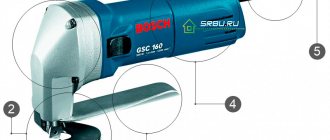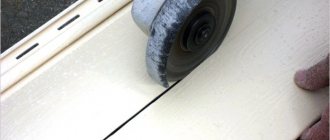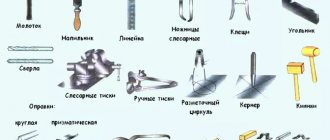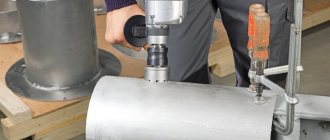Thin sheet metal used by many industries. It is impossible to imagine the repair and construction industry without this material. All kinds of products are manufactured on the basis of rolled sheets housing elements, pipes and a wide range of highly specialized products (slopes, corners, clamps, brackets, etc.). When working with thin sheet metal, a craftsman cannot do without such a tool as metal scissors.
The average metal shears are capable of cutting rolled products with a thickness of 0.8-1.3 (mm). Of course, there are more powerful scissors, with a cutting thickness of 2-3 (mm).
Metal shears are a type of metalworking tool that can be used to easily and quickly cut: sheet metal, thin-walled pipes, construction metal profiles and other metal-based materials. Mechanical hand shears for cutting metal consist of a lever-type handle and blades . In addition to mechanics, there are hydraulic, pneumatic and electric models. The types of metal scissors will be discussed below in the text.
How to choose metal scissors.
Classification of metal scissors
If we speak of traditional mechanical metal scissors, which are designed for hand grip, this series of tools can be classified according to the cutting direction:
- Left
- Rights
- Split
- Universal
The range of work performed mainly depends on the direction of the cut.
- Left-handed scissors are considered classic, as they are designed for right-handed people. The left cut involves a cutting line straight and to the left.
- Right-handed scissors are designed for left-handers. This type of metal cutting scissors is suitable for straight and right cutting.
- Cutting shears are designed for cutting sheet metal in a straight line.
- With universal scissors you can cut in any direction and with any hand.
Below is a video that explains in detail about the types of metal scissors.
Classification
Large metalworking enterprises and small workshops are equipped with equipment for guillotines, which differ in the following parameters:
- drive type;
- productivity;
- power level;
- maximum metal sheet thickness;
- presented rental;
- the number of operations performed.
Cutting products operate on the principle of applying pressure and the sharp edge of guillotine shears to the workpiece. The two elements of the device move relative to each other. This process includes two operations at once - cutting and breaking. High-quality equipment does the job in a 90:10 ratio. It is worth noting that the resulting cut is smooth and does not require additional processing.
Important! Don’t forget about safety - when working with tools, be sure to wear gloves made of very thick fabric or with leather stripes.
Now let's take a closer look at the types of guillotine shears depending on the drive.
Hydraulic
Machine equipment for cutting/chopping metal sheets with a special hydraulic drive is a highly productive and powerful type of industrial guillotine. They are used both for serial and piece production of metal products with straight edges from a material whose thickness is from 2 to 20 mm, and the cutting length is from 1 to 3 meters.
For large companies specializing in mechanical engineering, hydraulic equipment is manufactured, the technical parameters of which are higher: sheet thickness - from 20 mm, and cutting length - up to 6 meters. They are characterized by significant weight and dimensions, therefore they are produced individually. Modern automated CNC machines equipped with hydraulic guillotine shears are often used. Setting up the system is minimal in time, and to control the machine you only need to press one button.
Among the nuances, they note absolute noiselessness during operation, which cannot be said about other types of devices. In a hydraulic installation, the knives make smooth, unsharp movements, and there are no shock effects at all. Such machines are equipped with various photo sensors and protective screens, so the work process is safe.
Electromechanical
In terms of productivity, this type of guillotine is similar to the previous one, but is characterized by a high noise level when the knife impacts a metal sheet. The electromechanical installation is used in large or medium-sized workshops where high-precision cutting of workpieces of significant size and thickness is necessary. Such equipment is also relevant for mass production, only scissors with less power are selected as a tool. Electromechanical guillotines take up little working space, but allow you to work with different materials: steel, copper, plastic, aluminum, etc.
Some devices are capable of automated operation - they are equipped with CNC, which speeds up the process. They are distinguished by their simplicity, low cost and wide range of applications. You can use such equipment even in a home workshop or small workshop.
Pneumatic
To operate this guillotine, a compressor is required; as an analogue, a central line is used, in which compressed air is present. This equipment is relevant for large metalworking plants engaged primarily in large-scale production.
How the blades are connected
Additionally, mechanical manual metal shears can be classified according to the principle of connecting the blades:
- Direct
- Off-axis (pelicans)
The type of edge obtained on the cut will depend on the principle of connecting the blades.
- Scissors with direct connection of blades cut freely only to the length of the knives. When making long cuts, the craftsman will need to bend the edge and use extra force to make a long cut. Direct connection of blades works well when making only short cuts, not exceeding the length of the blades.
If you make long cuts with scissors for cutting metal with a direct connection of blades, the edge will receive numerous bends, creases and burrs. If such scissors are used for long cuttings, then only as part of the preparation of rough rough blanks.
- Offset shears are ideal for long sheet metal cuts. When cutting with such scissors, the lump does not touch the blades themselves, which eliminates the need to manually bend and force the cutting edge.
Pelicans are only useful for making long cuts. If a craftsman needs to make cuts that do not exceed the length of the blades, then scissors with an offset axis are poorly suited. After all, they use very large knives, which are inconvenient to manipulate when creating numerous short cuts.
What other types of metal scissors are there?
Hand scissors
Simple scissors for cutting metal are quite similar to household scissors. As a rule, the difference is in the size of the cutting surfaces and the shape of the handles. Their two parts - the handle and the cutting edge - are made from one piece of metal. There are two options for making these scissors:
- using forging;
- using casting.
Forged products are more expensive , but also much stronger. To give the cutting edge increased strength, this part is subject to additional hardening. This tool is rarely sharpened: the hard and durable edge cuts perfectly without periodic sharpening.
Cast products are a more economical option. They wear out faster and require frequent sharpening to cut properly. This tool is for cutting thin metal and for household use.
There are also mechanical scissors with lever transmission. In this case, the cutting edges are made of one, higher quality and denser metal, and the handles are made of simpler metal or its alloys. They are attached to each other using a system of levers. This design makes it possible to cut metal with little effort.
Regardless of the type - lever or regular - they come with blades of various shapes : straight - with straight knives, and there are left and right - for better cutting of curved contours. They differ in which of the levers is at the top:
- Right-hand scissors are so called because they are more convenient for making a smooth bend to the right. The instrument must be held in the left hand. When cutting, the right side of the blade goes under the sheet, which makes it possible to make a smooth edge of the curved line. To make it easier to distinguish, the handles are painted green.
- With left-handed scissors, on the contrary, it is easier to cut curves to the left. They must be used with the right hand. When cutting, the left side of the blades goes down. Handle color is red.
How exactly it will be convenient to cut long metal sheets depends on the shape of the blades. In a symmetrical tool, when cutting metal, the edge of the sheet rests against the blades. To cut further, you need to bend the sheet. As a result creases form and the plane becomes curved.
Slotted metal shears
Splined models are produced as a separate category of metal scissors . The scissors got their name from the type of edge obtained during cutting. Such scissors cut out a rectangular segment , which resembles the appearance of a slot for a key.
Slotted metal shears are valued for their ability to create smooth and neat edges . If, when cutting with ordinary scissors, the edges are bent, getting all sorts of nicks, dents, deformations and other damage, then when using slotted scissors, the edges are perfectly straight.
As with traditional tin snips, slotted models can be either mechanical or electrically or pneumatically driven.
Electric scissors - the principle of the device
When working with electric shears, the electric motor takes on the entire cutting load. The tool is distinguished by high cutting accuracy, making curved cuts without distorting the profile or sheet metal. Like most inventions, electronic scissors are powered by both mains and battery. Cordless tools quickly found their client - they are mobile, they can be used in narrow spaces or places remote from the power source, for example, on the roofs of buildings. Network tools are much more convenient and profitable to use for stationary work, for example, in a workshop.
As a rule, electric scissors are quite resistant to wear, since the body is made in most cases of metal, and the cutting part can be easily replaced if broken. Like many power tools, these scissors are equipped with a start lock in case of unexpected start-up. Based on the type of design and cutting method, construction scissors are divided into knife shears and nibbler shears. The principle of operation of knife versions is in many ways similar to the operation of manual ones - cutting occurs due to the interaction of moving and stationary parts. With this tool you can cut sheet metal up to 3 mm thick.
The main disadvantage of this type of tool is the need to cut only from the edge of the sheet. If you need to work starting from the inner point of the sheet, the most convenient option would be cutting with nibblers. Their design has a metal working element, similar to a chisel, which cuts through metal. In any case, to start cutting from the inner point of the sheet, you need to drill a small hole with a drill.
Roofing shears for metal
Roofing shears have become widespread ; they are also called “chair shears”. A distinctive feature of roofing shears is the design of one of the arms. One of the handles is created not for gripping by hand, but for support on a solid surface. It can also be clamped in a vice.
Roofing shears are designed primarily for cutting sheet metal of fairly large thickness. Roofing shears can make cuts in metal 2-3 (mm) thick .
Roofing metal shears have powerful blades and a long lever . The lever is usually operated with both hands at once. But if the model has an impact handle, then you can safely hit the lever even with a hammer or a small sledgehammer.
How to choose metal scissors, main parameters and characteristics.
Why do you need guillotine shears?
There is another type of scissors, which also belongs to the group of hand tools. They're called
guillotine, which consist of a frame, as well as a fixed knife and a movable blade. Due to their design, they are also called tabletop or stationary. To cut sheet material, it is necessary to place the sheet on the knife according to preliminary markings. The sheet is cut by lowering the cutting blade.
This type of tool is suitable exclusively for cutting in a straight direction. They are not suitable for circular cutting, so you should choose a tool depending on its purpose. Guillotine shears are used in industry when large volumes of work are performed. Manufacturers also produce hydraulic guillotine tools for cutting pipes, profiles and other compact non-sheet materials.

